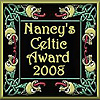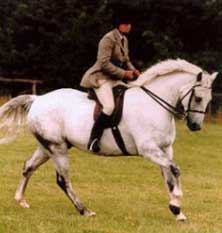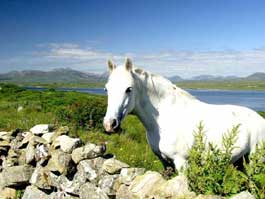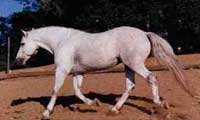| |

Traditions, folklore, history and more. If it's Irish, it's here. Or will be!
"People will not look forward to posterity who never look backward to their ancestors."
-Edmund Burke




Quotes
Library: Books, Movies, Music
Prints & Photos
Poetry
Jokes


Shops Ireland
Bunús na Gaeilge
(Basic Irish)
Circle of Prayer
Blessings
Did You Know?
Himself/Herself
Write to Us
Readers Write..
Links/Link to Us
Advertise with us
Awards & Testimonials
Submissions Guide


|
|
|
The Connemara Pony
by Bridget Haggerty

Connemara, in the west of Ireland, is famous for its rugged landscape of mist-shrouded mountains, desolate moors and bogs, and seemingly endless strands pounded by the waves of the stormy Atlantic ocean. It's in this often-inhospitable and unforgiving terrain that the Connemara Pony developed the qualities essential to survival - hardiness, agility and an extraordinary jumping ability.
The only breed unique to Ireland, the origins go back some 2,500 years to when Celtic warriors brought their dun-colored ponies onto the island and used them to draw war chariots and carts along the beaches and river plains. While the history is obscure, folklore tells us that the tribes of western Ireland were mounted in battle and used horses in everyday life. One legend says that in the 16th century, when the Spanish Armada sank off the Galway coast, the horses swam to shore and bred with the ponies running wild in the mountains. They learned to thrive on the sparse vegetation and to survive the hardships of their habitat. Here, one false step could be fatal.
As hard as life was for the Connemara Pony, it was equally as arduous for the rural folk trying to scrape out a living off the land. Customarily, farm families were large. This meant that, for many of them, they could afford just one good pony.
In the old days, ponies were captured in the mountains and then tamed. Traditionally, captives were always mares who could be bred each year to give the farmer a foal he could sell to augment his often-limited coffers; and the farmer who owned a stallion could add to his income by taking his pony from farm to farm to service the mares.
 From all accounts, life was an endurance test for any Connemara Pony who became part of an Irish family. She would pull a plow, a cart, and work from dawn to dusk at whatever task was needed under extremely harsh conditions. Fitted with baskets called creels, she carried a heavy load. She moved tons of rocks to clear the land. She carried seaweed from the shore which was used to fertilize the barren fields. And she carried turf cut from the bogs - her strong, sturdy legs able to maneuver through muck which might swallow a different type of horse. Never a day of rest, she also carted the family to Mass on Sunday and she competed equally in local races with the larger Irish Hunters and thoroughbreds.
From all accounts, life was an endurance test for any Connemara Pony who became part of an Irish family. She would pull a plow, a cart, and work from dawn to dusk at whatever task was needed under extremely harsh conditions. Fitted with baskets called creels, she carried a heavy load. She moved tons of rocks to clear the land. She carried seaweed from the shore which was used to fertilize the barren fields. And she carried turf cut from the bogs - her strong, sturdy legs able to maneuver through muck which might swallow a different type of horse. Never a day of rest, she also carted the family to Mass on Sunday and she competed equally in local races with the larger Irish Hunters and thoroughbreds.
Over time, the breed evolved into one that was distinguished by its hardiness, stamina and gentle disposition. If a mare didn't have all of these qualities, she was replaced with one that did. In 1923, to conserve and further develop the breed, the Connemara Pony Breeders Society was founded in Clifden. Centuries of natural selection, some interference needed for human survival, followed by the past 80 years of selective breeding has given us the quality Connemara we have today.
The Connemara is the largest of the pony breeds, ranging in height from 13 to 15 hands, with 14 to 14.2 hands as the average. Full maturity is at five years of age, sometimes older, and they can live well into their 30's. The most common colors are grey and dun, but there are blacks, bays, browns, chestnuts, palominos, and an occasional roan. Easy keepers, they do not require a rich diet to stay healthy and fit.
With their natural jumping ability and a rectangular build which makes them suitable for dressage, they often beat horses 16 hands and over with staying power, intelligence and heart. As a show jumper, working hunter, eventing, western pleasure, endurance, driving - Connemaras can do it all!
The popularity of the breed has extended worldwide and Connemara Pony Societies have been established in 17 countries - England, America, Australia, New Zealand, France, Finland, Norway, Sweden, Denmark, Belgium, Germany, Italy, South Africa, Switzerland, Holland, Austria and Canada. In fact, the pony is now so popular around the world that it has 2,230 web sites on the Internet!
 The International Connemara Pony Show. The International Connemara Pony Show.
The largest display of the finest Connemara Ponies in the world takes place in Clifden, Connemara in August of every year. The Show has been organized by the Connemara Pony Breeders Society since 1924 and more than 500 ponies travel from all over the country to take part.
It is a huge gathering from home and abroad. In recent years the International Connemara Pony Societies have brought large groups from Sweden, Australia, France, the UK, Denmark and the USA. The universal appeal of the breed has seen the Connemara Pony Show become a major international event, with up to 60 per cent of those attending from overseas. Foreign breeders have the opportunity to meet Irish breeders and mingle in the exciting atmosphere where ponies are judged and sold. The finest specimens of the breed, including young foals, stallions, young stock, aged brood mares and ridden ponies compete in over 20 classes.
The event also features an arts and crafts competition organised in conjunction with the local Irish Countrywomen’s Association, along with a non-affiliated dog show and an Irish dancing competition, selection of the Show Queen, and an evening of entertainment called the Showdown.
Opening the 2003 show, Minister of State at the Department of Agriculture, Noel Davern, paid tribute to the Irish equine heritage. “To the Irish, horses are not simply an industry or a past time, they are a way of life and it is not surprising that, as such, the horse features large in our history, placenames and literature.”
 Famous Connemaras Famous Connemaras
Some legendary ponies include The Nugget. At age 22, he cleared a 7' 2" jump and subsequently won over 300 prizes internationally, earning over 4,500 pounds sterling in prize money. In 1939, Little Squire won the Open Championship by clearing fences of seven feet. The American Press dubbed him "the littlest horse with the biggest heart." Dundrum, Tommy Wade's Connemara gelding, became Supreme Champion at the Wembley Horse of the Year Show when he set a record by clearing a 7' 2" puissance wall. In 1961, he was regarded as show jumper of the century when he won five major events at the Dublin Horse Show. It was the first time in history that so many awards were won by the same rider, let alone the same horse! He was the International Jumping Champion from 1959 to 1963. Stroller, a Connemara half-bred became the only pony to have ever competed in an Olympic Games. He was a member of the British Team competing in the 1968 Olympics in Mexico, ridden by Marion Coakes. They won the Individual Silver Medal and he was one of only two horses to jump a clear round in the entire 1968 Olympics, clearing a puissance fence of 6' 10". These are just a few of the Connemaras that have made history - there are many others.
Station House Museum
The Station House Museum is situated in the recently restored Clifden Railway Station complex and is housed in the original Engine Shed built in 1895.
The ground floor is dedicated to the history and heritage of the Connemara Pony. The high roofed interior, with tall light-shedding windows either side, is the backdrop for montage panels of photographs and documents. These are well supported by memorabilia and artefacts. All the latter have an intimate association with breeders and ponies from the Western Seaboard throughout the last two centuries. The Curator, Pat Lyne, is the author of a trilogy of books on the breed. These and other relevant publications, together with postcards, videos, and posters, are on sale at the desk.
Resources:
Connemara Pony Breeders Society
Kentucky Horse Park - International Museum of the Horse
American Connemara Pony Society
An article by Maureen Loughman Abel in the October 1995 issue of The Western Horse.
Images:
Kentucky Horse Park - International Museum of the Horse
Paul healey from Connemara.net (Click for more great photos of Connemara)
|
|
Fri, Sep 27, 2024
 The Galway Hooker The Galway Hooker
This unique vessel, with its distinctive curved lines and bright red sails, originated in the village of Claddagh. During the 19th century, hookers supported a significant fishing industry and also carried goods, livestock and fuel. Seán Rainey is remembered for building the last of the original boats, the Truelight, for Martin Oliver who was to become the last king of the Claddagh; as king, he was entitled to white sails on his boat. Since the mid seventies, many of the old sailing craft which were on the verge of extinction have been lovingly restored and new ones have been built. During the summer months they can be seen at festivals such a Cruinniú na mBád - the Gathering of the Boats - in Kinvara.
Click for More Culture Corner.
Lots of coloured photographs are the heart of this booklet and make it
worth owning even if you cannot read English. The author is a much travelled and respected international and NPS panel judge who has bred and exported prize winning Millfields stock all around the world since 1967. A fascinating insight into the breed's origins and performance.
Click here for The Connemara Pony.
|
|
|




 The Galway Hooker
The Galway Hooker